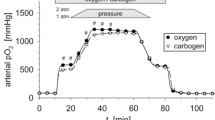Purpose:
To examine the influence of the hemorrheologic agent pentoxifylline (PTX) on tumor oxygenation and radiosensitivity.
Material and Methods:
Tumor oxygenation in rat rhabdomyosarcomas R1H after PTX administration (50 mg/kg body weight) was measured using interstitial pO2 probes (Licox CMP system and Eppendorf pO2-Histograph). Tumors were irradiated with 60Co γ-irradiation using single doses (15 and 30 Gy), conventional fractionation (60 Gy/30 fractions/6 weeks), and continuous hyperfractionation (54 Gy/36 fractions/18 days) in combination with PTX or an equivalent volume of physiological saline. Radiation effects were determined by tumor growth delay (2Vo), and by partial and complete tumor remission.
Results:
PTX increased tumor oxygenation for up to 45 min after administration of the drug. Single doses of 15 and 30 Gy of irradiation, when combined with PTX, produced little radiosensitization of the R1H tumors as indicated by dose-modifying factors (DMFs) of 1.11 and 1.04, respectively. In conventional fractionated irradiation with PTX, a DMF of 1.10 was obtained only. However, in continuous hyperfractionated irradiation with 18 × 50 mg/kg of PTX, the DMF with respect to tumor growth delay was found to be 1.37. Local tumor control was not influenced by PTX. In vitro studies identified R1H cells as p53 wildtype and showed a G1 arrest in response to irradiation. When 2 mM PTX was given prior to irradiation, it did not improve radiosensitivity of R1H cells as measured by clonogenic survival assays.
Conclusion:
PTX effectively enhances tumor oxygenation and radiosensitivity of R1H rhabdomyosarcomas, especially during continuous hyperfractionated irradiation. Given to rats as an adjuvant to fractionated irradiation, PTX does not enhance acute or late skin reactions or tumor metastasis. No radiosensitization was observed in vitro, when oxygen was not limiting. The observed radiosensitization by PTX is caused mainly by improved tumor oxygenation.
Ziel:
Der Einfluss der hämorrheologisch aktiven Substanz Pentoxifyllin (PTX) wurde in Hinblick auf die Tumoroxygenierung und Strahlensensibilität untersucht.
Material und Methodik:
In Rhabdomyosarkomen R1H der Ratte wurde die Tumoroxygenierung nach PTX-Applikation (50 mg/kg Körpergewicht) mit invasiven pO2-Sonden (Licox-CMP-System und Eppendorf-pO2-Histograph) gemessen. Tumoren wurden mit Einzeldosen (15 und 30 Gy), konventioneller Fraktionierung (60 Gy/30 Fraktionen/6 Wochen) und kontinuierlicher Hyperfraktionierung (54 Gy/36 Fraktionen/18 Tage) in Kombination mit PTX oder äquivalenten Volumina physiologischer Kochsalzlösung bestrahlt. Die Strahlenwirkung wurde mittels „tumor growth delay“ (2Vo) und lokaler Tumorkontrolle bestimmt.
Ergebnisse:
PTX erhöhte die Tumoroxygenierung bis zu 45 min nach der Applikation. Einzeldosen von 15 und 30 Gy in Kombination mit PTX erhöhten die Strahlensensibilität des R1H-Tumors nur gering und ergaben dosismodifizierende Faktoren (DMF) von 1,11 bzw. 1,04. Bei konventioneller Bestrahlung mit PTX wurde ebenfalls nur ein DMF von 1,10 erhalten. Eine kontinuierliche hyperfraktionierte Bestrahlung mit 18 × 50 mg/kg PTX ergab jedoch einen DMF von 1,37 in Bezug auf den „tumor growth delay“. In der lokalen Tumorkontrolle gab es keine Unterschiede. In-vitro-Untersuchungen identifizierten die R1H-Zellen als p53-Wildtyp und zeigten einen G1-Block nach Bestrahlung. Wenn vor der Bestrahlung 2 mM PTX gegeben wurden, wurde die Strahlenempfindlichkeit der R1H-Zellen nicht erhöht, wie der Kolonietest zeigt.
Schlussfolgerung:
PTX erhöht effektiv die Tumoroxygenierung und Strahlensensibilität von R1H-Rhabdomyosarkomen, besonders unter einer kontinuierlichen hyperfraktionierten Bestrahlung. Die Applikation von PTX als Adjuvans zu fraktionierter Bestrahlung erhöht nicht die akuten und späten Hautreaktionen oder die Tumormetastasierung. In vitro wurde keine Strahlensensibilisierung der R1H-Zellen unter Normoxie beobachtet. Die beobachtete Strahlensensibilisierung durch PTX ist daher hauptsächlich auf eine gesteigerte Tumoroxygenierung zurückzuführen.
Similar content being viewed by others
Author information
Authors and Affiliations
Corresponding author
Rights and permissions
About this article
Cite this article
Zywietz, F., Böhm, L., Sagowski, C. et al. Pentoxifylline Enhances Tumor Oxygenation and Radiosensitivity in Rat Rhabdomyosarcomas during Continuous Hyperfractionated Irradiation. Strahlenther Onkol 180, 306–314 (2004). https://doi.org/10.1007/s00066-004-1198-1
Received:
Accepted:
Issue Date:
DOI: https://doi.org/10.1007/s00066-004-1198-1




